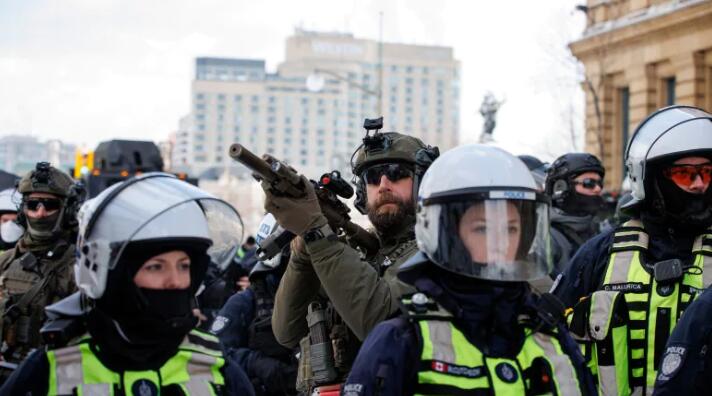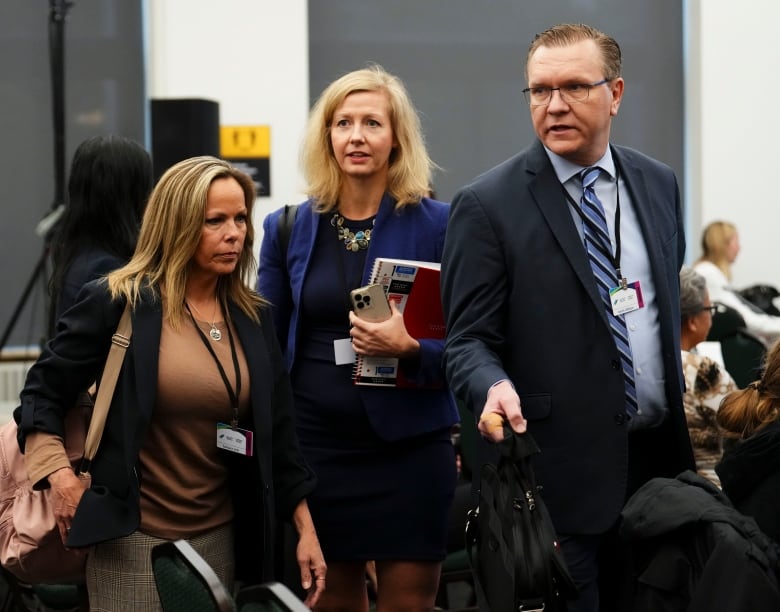Battle lines drawn as the Emergencies Act inquiry gets underway in Ottawa

Documents introduced at the inquiry will tell ‘quite the story,’ lawyer says
Eight months after anti-COVID-19 vaccine mandate protesters gridlocked parts of downtown Ottawa, a public inquiry has opened public hearings as it probes the federal government’s unprecedented use of emergency powers to clear the capital.
The Public Order Emergency Commission’s official launch this morning kicks off what’s anticipated to be a politically tense six weeks as the inquiry hears from federal government representatives about why they felt they had to invoke the never-before-used Emergencies Act, and from those who argue it was a step too far.
Invoking the act gave authorities new powers allowing them to freeze the finances of those connected to blockades and protests, ban travel to protest zones, prohibit people from bringing minors to unlawful assemblies and commandeer tow trucks.
The start of the inquiry saw some of the key players lay out sometimes conflicting views of that decision and what happened in Ottawa last winter.
Ontario Court of Appeal Justice Paul Rouleau, who has been chosen to lead the inquiry, kicked off the morning by explaining the commission’s mandate and the challenges it faces.
“A commission’s recommendations may be modest or wide-ranging. They may be directed at a range of audiences, including government, public bodies and the private sector,” said the commissioner.
“It’s also important to understand what commissions of inquiry do not do. They do not make findings of legal liability. They do not determine whether individuals have committed crimes. While inquiries seek to uncover the truth, they are not trials. Questions of civil and criminal liability are decided by courts and not commissions.”
The commission will introduce thousands of documents over the next six weeks as it examines the timeline of events leading up to the invocation of the act, the legal framework of the legislation and the government’s rationale.
Lawyer Paul Champ, who is representing a coalition of community associations and business improvement areas in downtown Ottawa, has seen some of those documents already. While he’s prohibited from talking about their contents, he said they aren’t flattering to the various levels of government and law enforcement involved.
“I think there’s going to be a very disturbing story to be told,” he said.
“I think we’re going to see where some of the balls are dropped. We’re going to see that there were a lot of disagreements, there were a lot of arguments and dysfunction between key actors. And it’s going to be quite the story.”
- Downtown residents still ‘traumatized’ by convoy, lawyer tells commission
- 65 witnesses set to testify at inquiry into use of Emergencies Act
The opening day saw battle lines taking shape as lawyers for key players — including the federal government, the provinces of Alberta and Saskatchewan, Ottawa police and protest organizers — gave brief opening remarks.
“It’s important for Canadians to understand the unprecedented critical situation that the country was facing earlier this year,” said Robert MacKinnon, a lawyer for the federal government, during his stint a the podium.
“The government witnesses will outline the deliberate step-by-step process in which careful consideration was given to all the available options, which led to the declaration of a public order emergency as a matter of last resort.”
A lawyer for the convoy organizers said the government never met the legal threshold to invoke the act.
“It is our view there was no justification whatsoever to invoke the Emergencies Act,” said Brendan Miller.
“The government exceeded their jurisdiction both constitutionality and legislatively.”
Sloly’s lawyer blames limited resources and intelligence
One of Peter Sloly’s three lawyers said the former chief will provide “first-hand knowledge of how the events unfolded.”
Sloly resigned as chief in the middle of the Freedom Convoy protest as frustrations mounted over how the protest was policed after trucks were permitted to park on downtown streets, blockading the capital.
“In particular, he will explain to you the limited resources available to the Ottawa police service to deal with a massive occupation. The limited nature of the intelligence available to OPS about what was coming Ottawa’s way,” said Curry.
“He will also tell the commissioner why he signalled on Feb. 7 that there may not be a policing solution alone to the occupation.”

A lawyer for the Ottawa Police Service said it was “impossible to gauge” the number of vehicles and participants in the crowd.
“The Ottawa police, you will hear, followed that well-established process that had always worked with protesters this time as well, and were prepared for an event, but not for the event that occurred,” said David Migicovsky.
“The protest became dangerous, and the situation became volatile.”
People in Ottawa were ‘terrorized:’ lawyer
Another police agency says it was engaged with the protesters.
“You’ll hear that the OPP became engaged well before the Freedom Convoy reached the Ontario border,” said Chris Diana, counsel for the Ontario Provincial Police.
“You will hear about the OPP’s intelligence gathering process and the way that the OPP disseminated intelligence to its policing partners and the timing of sharing that information as the convoy moved across Canada.”
Champ said his clients aren’t going to take a position about the invocation of the Emergencies Act. He said they want to make sure the official record reflects what people in Ottawa experienced over the three weeks when protesters were using trucks and other vehicles to blockade some of the city’s main arteries and neighbourhoods.
“I don’t think people really quite get how traumatized, and quite frankly terrorized, the people of Ottawa were,” he said in an interview with CBC Wednesday.
“Public services were completely interrupted. Ambulances had a hard time getting downtown. Buses were stopped, Para Transpo was stopped. Senior citizens, people with disabilities were significantly impacted.
“People were hostages in their own homes. And we want to make sure that that story is told.”
The protests started in opposition to the federal government’s vaccine mandate for cross-border truckers. It then expanded into a movement against broader public health measures to limit the spread of COVID-19 and took on broader anti-government sentiments.
While the heart of the protest was in Ottawa, blockades at the Canada-U.S. border in Windsor, Ont.. Emerson, Man. and Coutts, Alta. also played out, triggering economic concerns.
Lawyers representing Saskatchewan and Alberta used their Thursday remarks to question whether the federal government properly consulted the provinces before invoking the law and whether other policing measures could have curbed the protests.
Trudeau defends decision to invoke Emergencies Act
Prime Minister Justin Trudeau has continued to defend his government’s decision to invoke the Emergencies Act on Feb. 14, saying it was necessary “to get the situation back under control.”
“That’s exactly what we did,” Trudeau told a news conference Wednesday.
On Thursday, lawyers for the commission also presented overview reports summarizing the various protests that popped up against public health measures and lockdowns across Canada, culminating in the convoy to Ottawa.
Commission getting access to high-level documents
At Rouleau’s request, the Liberal government has waived cabinet confidence on documents related to its invocation of the act. It’s only the fourth time in Canada’s history that a public inquiry has been given access to such high-level documents.
- Ex-Ottawa police chief cites ‘declining level of trust’ for resignation during convoy
- RCMP feared that Mounties might leak operational plans to convoy protesters: documents
A lawyer for the Canadian Civil Liberties Association, which is taking the government to court over its use of the Emergencies Act, said she fears those sensitive documents won’t be made public.
“We are going into the commission with an open mind but, in our view, the government has yet to prove that the legal threshold to invoke the act was met,” Cara Zwibel told a news conference Wednesday.

“And the burden is on them. Not the other way around.”
The commission is expected to hear from 65 witnesses over the next six weeks, including Trudeau, cabinet ministers, government officials from Ontario and Alberta and convoy organizers, including Tamara Lich, who was in the room for Thursday’s opening, and Pat King.
Tamara Lich in attendance
Many of the convoy participants, including Lich, are facing criminal charges for their roles in orchestrating the demonstrations.
Keith Wilson, who is representing about 25 protesters, said their testimony during the inquiry is protected and can’t be used against them in court.
“Tamara Lich and Chris Barber and others who are facing criminal charges arising from the protests are safe to testify and be transparent and tell the truth. They’re obligated to answer the questions,” he said.
“[Lich] has provided all of her banking records, every last one and every every dollar is accounted for. All the donations that weren’t returned to the donors, which was the vast majority, are in a … court-supervised escrow fund.”
Wilson said she also has provided text messages to the commission.
High-profile witnesses expected
The commission also will hear from a number of police and security officials, including former Ottawa police chief Peter Sloly, RCMP Commissioner Brenda Lucki, the head of Canada’s spy agency David Vigneault and the head of the government’s Integrated Threat Assessment Centre.
- A full list of the anticipated witnesses can be found here
The commission is the first of its kind in Canada and is a legal requirement under the Emergencies Act. Through an order-in-council, the commission has been directed to examine the circumstances that led to the declaration of a public emergency and to examine the following issues:
- The evolution and goals of the convoy and blockades, their leadership, organization and participants.
- The impact of domestic and foreign funding on the protests, including money from crowdsourcing platforms.
- The impact, role and sources of misinformation and disinformation associated with the protests, including the role played by social media.
- The impact of the blockades, including their economic impact.
- And the actions of police and other responders prior to and after the declaration.
The commission’s first phase is scheduled to wrap on Nov. 25. After the fact-finding phase ends, the commission will begin a policy phase during which it will host roundtables with policy experts.
Rouleau’s final report is due in February — an undertaking he acknowledged will be a challenge during his opening remarks.

The commissioner noted that he is working on a tight timeline, pointing to the Air India inquiry, which had four years to complete its work, and the inquiry into Missing and Murdered Indigenous Women and Girls, which had nearly three years to write its final report.
Due to requirements in the legislation, the Emergencies Act inquiry’s work is “measured in days, not years,” said Rouleau.
Related News
Pentagon investigating Democrat senator for video urging troops to defy ‘illegal orders’
Arizona Sen. Mark Kelly speaks during a hearing on Capitol Hill in October. Kelly servedRead more
Anand says Canada taking public safety seriously as it pursues trade deal with India
Foreign Affairs Minister Anita Anand says Canada must change its foreign policy focus. (Nick Iwanyshyn/TheRead more
